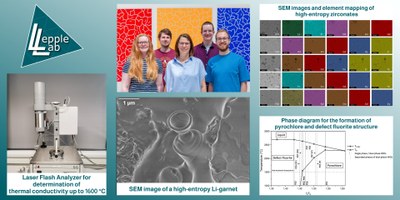October
Picture of the Month - October 2023
High entropy oxides as promising materials for efficient energy conversion and storage applications
High entropy oxides (HEOs) are a new class of materials that exhibit outstanding unique and tunable properties, making them promising for future efficient energy conversion and storage applications. HEOs are complex single-phase oxides composed of five or more cations in equimolar ratios. It is hypothesized that the metal cations thereby arrange themselves statistically on the cation lattice of the crystal structure, resulting in high configurational entropy. In this case, even compositions that have a positive enthalpy of formation can be stabilized above a certain temperature when the entropy term becomes larger than the enthalpy term resulting in a negative Gibbs free energy. This means that HEOs are stabilized at high temperatures, which makes them suitable for high temperature applications.
In addition to other energy-related applications, such as ionic conductors or catalysts, the use of HEOs at high temperatures in harsh environments is the subject of research of the LeppleLab. HEOs are promising candidate materials for thermal barrier coatings (TBCs) in gas turbines for propulsion or stationary energy conversion. TBCs protect the metallic components in the hottest zones of the gas turbine. One way to increase the efficiency of the gas turbine, and thus reduce fuel consumption and emissions, is to raise the process temperature, for which new materials are needed. In addition to high-temperature stability, HEOs also have other advantageous properties, including low thermal conductivity, which is determined using Laser Flash Analysis. Other TBC relevant properties, such as corrosion resistance, mechanical properties and thermal shock behavior are currently being investigated.
Publication: P. Hutterer, M. Lepple “Influence of composition on structural evolution of high-entropy zirconates – cationic radius ratio and atomic size difference”, J. Am. Ceram. Soc. 106, 2, 1547-1560 (2023). DOI: 10.1111/jace.18832
This picture was submitted by Prof. Dr.-Ing. Maren Lepple. It contains parts published unter the licence CC BY.
Further insights into the research activities of the ZfM groups can be found in the Gallery.

